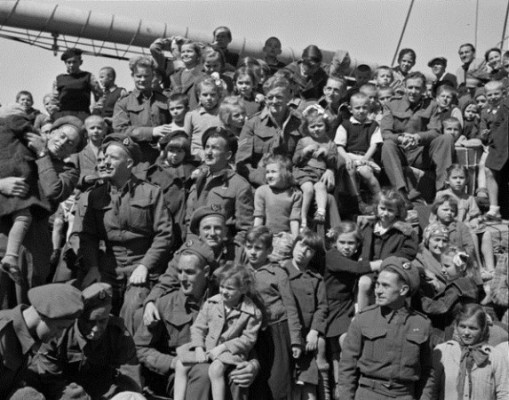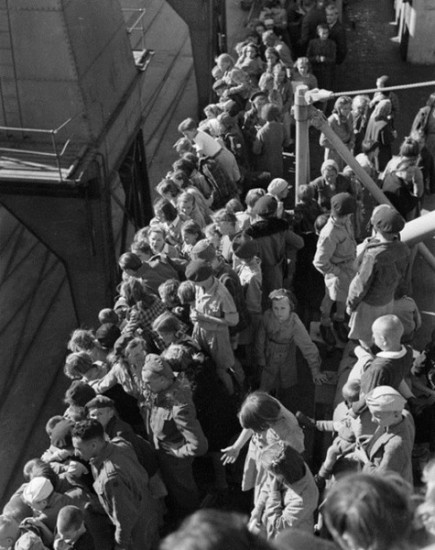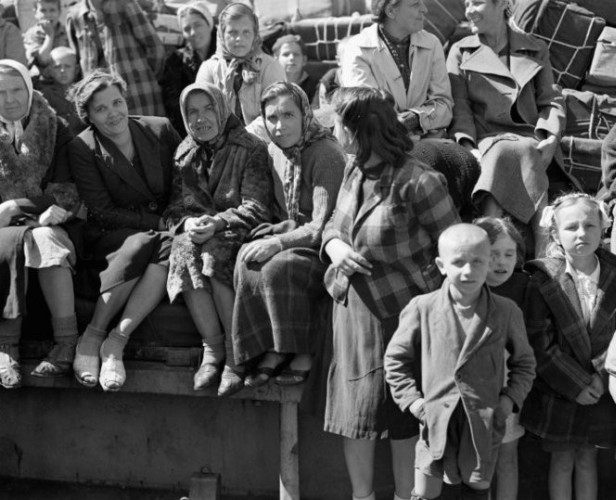BLUE SKIES, GREEN GRASS, AND WARMTH
by Barbara Scrivens
The much-anticipated uss general george m randall ap-115 eased her way into a sparkling Wellington on 1 November 1944.
As well as her beloved cargo of New Zealand sons, husbands and fathers, the troop ship carried 733 Polish children and teenagers—mostly orphans—and their caregivers.

Thousands of beaming New Zealanders on the docks matched the excitement on deck,1 the warm spring weather perfect for celebrating the Second New Zealand Expeditionary Force's return from action in Greece, Crete, Italy, North Africa and Burma.
The welcoming cheers paused as the children, who had never possessed a weapon or fired a shot in combat, walked down the gangplank with ill-fitting clothing and wary eyes. Boys had shaved heads. New Zealanders who read newspapers or listened to the radio knew of their impending arrival, but they were not prepared for the sight of so many young people sharing a collective and distinctive atmosphere of hardship.
They were the lucky ones—survivors out of hundreds of thousands forcibly removed from their homes in eastern Poland in 1940 and 1941 and incarcerated in NKVD (Soviet Secret Police and forerunner to the KGB) forced-labour facilities throughout the USSR. They sheltered in orphanages created by the Polish army as that army struggled to squeeze around 115,000 Poles—barely eight percent of those taken by the Soviets—out of Stalin’s territory.

Photographer John Pascoe boarded the ship that Wednesday. While most around her looked to shore, he caught the eye of this little girl, too small to look over people against the railings, and the little boy on the left-hand side of the foreground.2
“They were streaming off the ship, wondering no doubt what sort of a world it would be. There was no cheering that I can think of, but a solemn silence as the emotions of the Kiwis went out to the children. As a cameraman, I was visibly disturbed and I still feel it,” remembered Earl Bailey, who worked for movie news, and stood at one of the gangways.3
American personnel and Chinese airmen scheduled to train in New Zealand arrived with the 2nd NZEF. Dignitaries welcoming them included Prime Minister Peter Fraser, Minister of Defence Frederick Jones, Consul-General for China Wang Feng and several high-ranking American military officials. The Royal New Zealand Air Force band “added to the liveliness of the welcome.”4
While New Zealand veterans embraced their loved ones, the much younger cargo waited to disembark. They had arrived at the invitation of the New Zealand government to spend the balance of the war “where they can continue their education and enjoy in the sanctuary of New Zealand the peace which their own land cannot at present offer.”5
… they were unused to seeing so many smiling faces. They knew adults as serious.
Local medical officials examined the children and their 105 caregivers. Possessions gathered, the Poles assembled on deck to receive their own set of dignitaries. This time Prime Minister Fraser joined Polish Consul Count Kazimierz Wodzicki and his wife, Maria, who was instrumental in the Polish-New Zealand refugee arrangement.
The Poles may not have understood Mr Fraser’s speech but they understood the welcome.
A Polish girl recited in English: “Thank you very much for what you have done for us Polish children by inviting us to your beautiful country. God bless you. Long live New Zealand.” The children then sang to their Consul and the rest of the welcoming party.6
One can understand the children’s quiet demeanour among all the fuss: Besides taking time to absorb their new surroundings, they were unused to seeing so many smiling faces. They knew adults as serious; all but the youngest of the children had intimate knowledge of hunger, extreme deprivation and death. Many of them had seen family members die—during transportation to forced-labour facilities in the USSR; within those facilities; as they trudged hundreds of kilometres towards freedom; or in transition camps between Uzbekistan and Persia (now Iran).
A reporter for the evening post noted:
Except that some were still showing the effects of their sufferings in Europe [sic] and that some had the striking blonde beauty seldom seen in this country, the Polish children who arrived recently as guests of the Dominion were very much like New Zealand children. Yet there was a pitiful difference, and it lay in the fact that although they played about or watched visitors inquisitively, they made hardly any noise and spoke to each other in such soft, low voices that one was not even conscious that they spoke a foreign language.7
The children provided a popular diversion on a transport ship that included many fathers. Another article told of:
… one of the most popular amusements on the trip [was] to line the deck rails overlooking the cargo hatch they had adopted as their main playground and to watch the young émigrés play, and it must be confessed, fight, during their voyage—a voyage which was for most the first time they had been on a ship and certainly the first time on such a friendly one.8
For most of the newly arrived Poles, this had been their third experience on a ship. In 1942, many had crossed the Caspian Sea on old cargo vessels that lacked any designated sleeping, dining or sanitary facilities. They left from Krasnovodsk (now Turkmenbashi) in Turkmenistan (then part of the Soviet Union) and landed in Pahlevi (now Bandar-e Anzali) in northern Persia.
Some had been left in Russia by desperate mothers unable to feed them, and who believed they stood a better chance of surviving in the institutions.
Soldiers enlisted in the new Polish army left the USSR first. They shared the crossing with orphans and their caregivers. The last transports carried mostly civilians. Ragged, skeletal bodies filled every available space. Stormy weather conditions created extra challenges on some of the 43 trips. Those who survived—after processing and disinfecting in Pahlevi— moved to military and refugee camps farther inland.
Some of the orphans arrived in Teheran overland from orphanages in Ashgabat, Turkmenistan, through the Kopet Dag mountain range (Köpetdag Dagersi) and via Mashhad.
Most of the parentless Polish refugees settled in Isfahan, which became known as The City of Polish Children. Some of the children had arrived through authorities such as the Red Cross. Some had been left in Russsia by desperate mothers unable to feed them, and who believed they stood a better chance of surviving in the institutions. Some had said goodbye to their parents when they joined the army. Some had siblings. Some had mothers working in the orphanages.
The 838 Poles accepted by the New Zealand government gathered as a group for the first time at a transient camp in Ahwaz near the Persian Gulf. The cargo steamship sontay took them across the Arabian Sea to Bombay. Józef (Joe) Jagiełło, then eight years old, remembered that “slow cargo ship” as:
“… terrible, they didn’t have facilities for us and we were getting rations of smoked fish and bread and water. For years afterwards I hated the smell of smoked fish.”
He described the uss general randall as:
“… like heaven… It was such a huge ship, there was plenty of room to run around in… everybody had bunks… the cookhouse never closed.
“I forget how many cookhouses, or dining areas, there were, but they never seemed to run out of food. Whenever we felt like having something to eat, we’d look through the door, and the cooks would see us, and they’d wave at us to come in. They’d sit us down and bring us food. It didn’t matter when.
“For the first time we had Weetbix… and bacon and eggs and the food was cooked. You had hot meals.”
“It was the first time I sat down for a meal. We had had knives and forks, and all that. We didn’t know what to do with them. They had to teach us how to use them. For the first time we had Weetbix and Cornies [Cornflakes] with milk—and sugar—and bacon and eggs and the food was cooked, you had hot meals.”
“There were certain places they wouldn’t allow us to go, but we were running up and down ladders and things. There were four bunks above one another—they were swinging bunks, and that was great. They got us organised to do an escape drill. They blew a siren and we had to rush up and put lifejackets on and we’d go to the [life]boats.
“It was great when they used to practise shooting. A little monoplane used to come and towed this huge balloon behind it and the guys in the Navy would start shooting, and when they hit the balloon, we’d all cheer.
“They used to have a practice when the siren would go and we used to notice the boat would zig-zag. We used to watch the wake and they said it was in case there was a submarine or something… We were going across the Indian Ocean.”
The ship’s doctor had his hands:
… kept busy attending to bruises and abrasions, but the general health of the children had been much improved by the sea voyage and wonderful care.9
At five in the afternoons, troops were:
… ordered to their quarters and the children given the freedom of the decks until after seven. When the time came for the children to go below, the order was given in Polish over the loud speakers. It was not long before the men could reel off this order, unaware of the meaning of the words they were pronouncing, and as soon as the order started to come through the loud speakers the men all over the ship took it up and chanted it with good humour at the tops of their voices.10
The Polish children acknowledged the ship’s hospitality with a concert for the officers. A New Zealand soldier taught the older girls his national anthem, which they sang to a surprised audience at the Palmerston North railway station when their trains stopped for water and refuelling.
The photographs taken of the children the day they landed tell their story better than any words. There are smiles, some hesitant, some bright. There are eyes that have seen too much. There are frozen lips. There are hugs for the New Zealand soldiers holding some of the younger children, and laughing responses to the men’s own smiles.
According to the auckland star that day, the youngest refugee on the ship was 14 months and the oldest a 72-year-old woman. The adults included 42 teachers, two doctors, a dentist, four tradesmen, 36 single women and six single men.11
The sole toddler was with her 21-year-old mother. The youngest children were four. There were 132 families of two people, 44 of three, 19 of four and 14 of five. Four families had six members and three had seven.
One family of eight siblings ranged in ages between eight and 17. In another, a 15-year old sister, Anna Mokrzycka, had seven siblings, the youngest six. Sister-guardians from seven other sibling-only families became staff at the Pahiatua camp. Only two families arrived in New Zealand with both parents.

The group’s missing fathers, brothers and sisters—still living—were in the Polish army, either having fought in northern Europe and Italy, or with the Polish military cadets in the Middle East.
During the Poles’ escape from Russia, it was an advantage to have a family member in the Polish army because the entire family automatically came under its auspices.
Most family groups arriving in New Zealand had single mothers, some shown above.12 Two single fathers accompanied their children. Men not accepted into the army were generally medically unfit or too old. The group included a priest and three nuns.
Nearly 200 children and teenagers between five and 15 had no familial connections, almost 60 of them younger than 10. On that November day Joe still believed his father, Franciszek, was alive and continued to make up reasons for his lack of letters.
Fifty years later a chance visit to the Auckland Museum led Joe to discover that by the time he landed in Wellington, his father had already been killed in action in Italy. Franciszek and Joe had travelled together to the Polish army’s enlistment station in Ashkhabad, southern Russia, after Joe's mother and grandmother died in Siberia. Joe last saw Franciszek when he left for training in Egypt. Joe moved from one orphanage to another until he was selected to travel to New Zealand. (See Joe's full story on this page.)
Joe soaked up the smiles in the crowds on shore that flawless Wellington day.
“When we arrived in New Zealand we thought what a lovely place it was because it was so nice and green and there were all these little houses up on the hills. It was so beautiful, the harbour was like a lake. We couldn’t believe we were in such a beautiful place, after being in Persia where everything was always sort of brown.”
For Joe it got even better when he was ushered onto a train.
“We didn’t know where we were going but we were so pleased that for the first time we went on a train that actually had seats! We remembered being on cattle trucks or freight trucks where there was no seating. You had to sit on the floor or stand up and all of a sudden we had seats to sit on and the train slowed right down at every little railway station and there were thousands of people waving and clapping and everybody laughing, you know, and cheering.
“…and we thought, ‘They’re all happy, everybody is happy to see us.’”
© Barbara Scrivens, 2015
Updated September 2017
ENDNOTES:
- 1 - Pascoe, John Dobree, 1908-1972, New Zealand soldiers with Polish refugee children on
board the General Randall, Wellington Harbour. Photographic albums, prints and negatives. Ref: 1/2-003639-F. Alexander
Turnbull Library, Wellington, New Zealand:
http://natlib.govt.nz/records/32058562. - 2 - Pascoe, John Dobree, 1908-1972, Polish refugees arriving in Wellington on board the General
Randall. Photographic albums, prints and negatives. Ref: 1/2-003642-F. Alexander Turnbull Library, Wellington, New
Zealand:
http://natlib.govt.nz/records/32058567. - 3 - New Zealand’s First Refugees, Pahiatua’s Polish Children, page 258, published by the Polish Children’s Reunion Committee, 2004. ISBN: 0-476-00739-9.
- 4 - Evening Post, 1 November 1944, page 4, HOME-COMING, LARGE NZ DRAFT, RELEASE FROM SERVICE,
Papers Past, through the National Library of New Zealand:
http://natlib.govt.nz/records/17804507. - 5 - Evening Post, 1 November 1944, page 7, NZ HOME, YOUNG POLISH GUESTS, DAWN OF HAPPINESS,
Papers Past, through the National Library of New Zealand:
http://natlib.govt.nz/records/17804582. - 6 - Ibid. NZ HOME, YOUNG POLISH GUESTS, DAWN OF HAPPINESS.
- 7 - Evening Post, 1 November 1944, page 8, POLISH CHILDREN, A GOOD IMPRESSION, POPULAR ON
TRANSPORT, Papers Past, through the National Library of New Zealand:
http://natlib.govt.nz/records/17804605. - 8 - Ibid. NZ HOME, YOUNG POLISH GUESTS, DAWN OF HAPPINESS.
- 9 - Ibid. POLISH CHILDREN, A GOOD IMPRESSION, POPULAR ON TRANSPORT.
- 10 - Ibid. POLISH CHILDREN, A GOOD IMPRESSION, POPULAR ON TRANSPORT.
- 11 - Auckland Star, 1 November 1944, page 2. VICTIMS OF WAR, POLISH REFUGEES FIND HAVEN IN NZ, Papers Past, through the National Library of New Zealand.
- 12 - Pascoe, John Dobree, 1908-1972, Polish refugees on the General Randall on their day of arrival in New
Zealand. Photographic albums, prints and negatives. Ref: 1/2-003628-F. Alexander Turnbull Library, Wellington, New
Zealand:
http://natlib.govt.nz/records/22808023.
